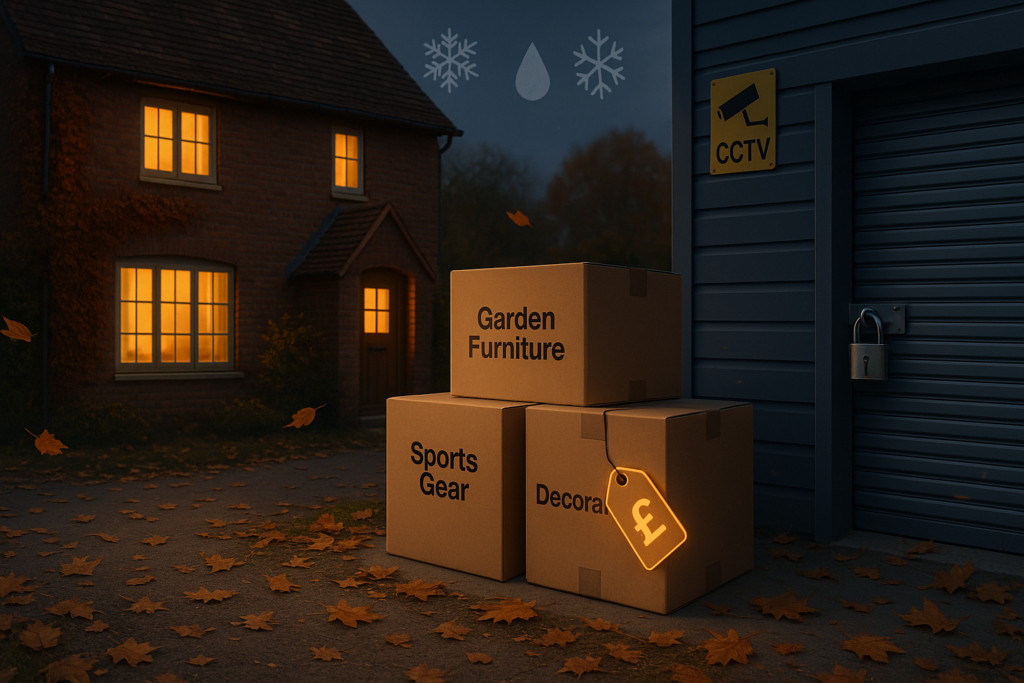As autumn leaves start falling and temperatures drop, many of us begin thinking about how to protect our homes and belongings. The UK’s damp, cold winters can damage everything from furniture to seasonal clothing and garden tools. That’s why self storage for winter has become such a practical option. It not only clears space at home but also safeguards items that might not survive the harsher months.
At the same time, costs matter. Understanding the cost of self storage and comparing self storage prices ensures you don’t overpay for peace of mind.
Autumn Decluttering: The First Step to Winter Storage
Before deciding what to move into storage, a quick autumn decluttering session is a game-changer. It helps you identify what’s worth keeping, what could be donated, and what really needs extra protection over winter.
Tips for a productive autumn declutter:
- Seasonal rotation: Pack away summer clothes, outdoor gear, and garden furniture you won’t use until spring.
- Organise by use: Keep frequently used winter coats, boots, and tools accessible at home.
- Reduce clutter: If you haven’t used it in two years, consider selling or donating it. This makes winter storage cheaper and more efficient.
Recommended: 6 Winter Storage Disasters You Should Avoid at all Costs
Protecting Your Home Before Winter Hits
Winter in the UK can be tough on homes. Burst pipes, draughts, and damp patches are common complaints. Before moving items into storage, make sure your house itself is ready.
- Check insulation and draughts: Loft insulation should be around 270mm to keep heating bills lower (British Gas).
- Clear gutters and drains: Blockages cause water to overflow, leading to damp walls and damage.
- Lag exposed pipes: Pipe insulation reduces the risk of freezing and bursting in unheated spaces.
- Ventilate properly: Short bursts of fresh air help prevent mould, which Public Health England has linked to health risks (GOV.UK report on damp and mould).
What to Store: Choosing Items for Winter Storage
Not everything in your home needs to be put away, but some belongings are better off in a secure unit:
- Garden furniture & tools: Protect wood, rattan, and metal from rain, frost, and rust.
- Sports gear & bikes: Exposure to damp can ruin leather, fabric, and moving parts.
- Electronics and books: These are vulnerable to moisture and temperature fluctuations.
- Seasonal décor & bulky items: Keep Christmas decorations, camping gear, or patio heaters safely stored until needed.

When preparing items for winter storage:
- Clean and dry everything first.
- Use breathable covers instead of plastic wrap for fabrics.
- Raise boxes off the floor to prevent moisture damage.
Understanding the Cost of Self Storage
So, how much should you expect to pay for storage? The cost of self storage varies depending on location, size, and features. According to the Self Storage Association UK, average rents sit around £29.13 per sq ft per year (SSA UK Annual Report).
A 25 sq ft unit in London can cost £30–£40 per week, while the same size in the Midlands might be closer to £15–£25. Features like climate control, CCTV, and extended access hours increase self storage prices.
Don’t forget about storage insurance! Most facilities require it, and external providers can be cheaper. Some third party providers include Surewise and Store Insure among others.
How Self Storage for Winter Saves You Money
It may feel like an extra expense, but self storage for winter can reduce costs in the long run. Here’s how:
- Lower home energy bills: Fewer items crammed into rooms makes heating more efficient.
- Prevent damage costs: Furniture and electronics kept in dry storage won’t suffer from damp or mould repairs.
- Avoid replacement costs: Seasonal gear lasts longer when protected, meaning you don’t have to rebuy every year.
Think of it as an investment in protecting what you already own.
Tips for Getting the Best Self Storage Prices
To make the most of your budget:
- Shop around: Compare three or more local providers. Introductory deals can save up to 50% for the first three months.
- Choose the right size: Measure items and only pay for the space you need. Too big a unit means wasted money.
- Book early in autumn: Demand rises before Christmas, and so do prices.
- Bring your own lock and packaging: Buying these on-site is often more expensive.
- Check insurance options: Sometimes third-party cover is cheaper and more comprehensive.
- Action Plan: Combine Autumn Decluttering with Winter Storage
Here’s a quick self storage for winter checklist:
- Declutter in autumn to decide what to keep, store, or donate.
- Protect your home from damp, leaks, and frozen pipes.
- Choose items suitable for winter storage and prepare them properly.
- Compare the cost of self storage in your area before signing up.
- Insure your belongings for full protection.
Our Thoughts on Self Storage for Winter
Getting ready for the colder months doesn’t have to be stressful. By tackling autumn decluttering now, you’ll not only enjoy a warmer, safer home but also make smart use of self storage for winter. Whether you’re protecting garden furniture, sports gear, or family keepsakes, winter storage is a cost-effective way to avoid damage and keep your home comfortable all season long.
Ready to Make Winter Storage Easy?
If you’re planning some autumn decluttering or looking for reliable self storage for winter, Space Centre Self Storage offers clean, dry, and secure units at affordable rates. With transparent pricing (no hidden extras), flexible contracts, and a choice of unit sizes, it’s simple to protect your belongings and save space at home this winter.
Find your nearest Space Centre Self Storage branch and get a free quote today.